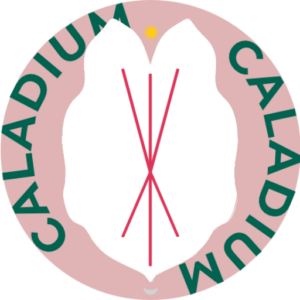You have your potted Caladium tuber and you need to find the perfect location for it.
Like any other plant, the Caladium needs light to live. And unlike many other tropical plants, especially the colorful Caladium cultivars need more light to show their beautiful colors.
How do you start looking for a location now, though, and do you have to treat the tubers differently than the plants to begin with? In this post, you’ll learn all about location for your caladium tubers and plants.

Where to put Caladium tubers?
First, it’s important to wake your tuber from its winter dormancy. To do this, your caladium tuber needs it warm and moist. This means that tubers need daytime temperatures of 20 to 25 degrees Celsius to sprout roots and leaves.
If you use a substrate mix as described in the section on Soil for Caladium, you will have a good foundation for maintaining long-term moisture in your substrate. Especially in the beginning, make sure that the tubers are sufficiently watered. To keep the humidity high in the growing phase, you can, for example, close the pot with some plastic wrap and a rubber band.
Of course, you can also put the pot in an indoor greenhouse or otherwise enclose it with plastic wrap, for example. Ventilate closed containers regularly to prevent the tubers or soil from mold.
Caladium Plant: This is the perfect Location
The perfect location for your Caladium looks like this
- bright location without direct sunlight
- warm location with above 20° Celsius
- humid location with high humidity
Not always the growing location is the same as the location of the later to grow plant. So I grew some of my plants under artificial growlight. When the first shoots are visible, the Caladium moves to their location in the apartment.
It is important to notice, that the Caladium plant likes it bright, but no direct sunlight.
What does this mean in reality? For me, the white caladium species are in high old building southwest window. Bright species are for example the Caladium candidum, Caladium Fiesta or the Caladium White Christmas. So mostly species with high white percentages are in my brightest window.
Pure south windows always carry the risk that the plants get direct sunlight but in our specific case, although the window is bright, we do not have direct sunlight thanks to a large maple in front of the house. Another part of our Caladium plants are in the north window on the other side of the apartment. Here it is not quite so bright, but for species with pink leaves, the brightness is enough in my case.
Avoid direct sunlight: Beware of burns!
Caladium leaves are rather delicate due to their coloration and leaf structure. This does not make finding the perfect location any easier. It is important that your plants are protected from direct sunlight, because especially the leaves of the white caladiums can burn quickly.
Humidity for Caladium must be as high as possible
Once your plant has formed leaves, you should make sure that it is not in the driest room in your home. A bright bathroom would probably be best, but in reality very few city apartments have bathrooms with windows these days, leaving only the other rooms of your apartment to keep the plants happy.
Here it is therefore even more important to make sure to keep the humidity somehow high. But how does this work in practice?
Many plants:
You need an argument to increase your plant collection? Then just mention that a lot of plants favor each other because they keep humidity high for themselves (on a very small scale). Of course, this only works on a small scale and you won’t reach values beyond 60% with it, unless there are hundreds of plants in a small space.

Humidifier:
You have enough plants or simply no more space (because enough plants you actually never have), so there is also the possibility to increase the humidity with technical aids. There are small mini humidifiers and also larger devices that let you adjust the humidity very precisely.
While the small humidifiers often don’t do much, the larger units are good to use depending on the size of the room.
Spray:
Another option is to spray the plants regularly. Here it should be mentioned that this method is the most ineffective and also the variant that can cause the most damage. First of all, it is important that the applied water must be able to dry relatively quickly to prevent fungal diseases on the leaves. In addition, the water droplets are a risk factor, as they act like a magnifying glass in direct sunlight, causing the plant to burn within a few minutes.
Evolution of Caladium tubers
Now you have the planted tuber in the perfect location, but where do you go from here?
The plants need some time to sprout the leaves. If everything went right, you will see the first leaf tips in the soil after about 2 to 4 weeks. The leaves will develop out of this tips. Depending on temperature and lighting conditions, this can happen faster. The leaf tips will eventually open slowly and the first leaves will appear.
Now it’s time to wait and water. You’ll learn how to properly care for and water your Caladium plants in the next chapter all about watering caladiums.




